The G tablet may have been designed to suit the crew members
onboard the vessel O'Higgins, i.e. created for people belonging
north of the equator - those who had adopted a heliacal world view.
... The officers of the Chilean corvette O'Higgins received
this tablet and the Large Santiago Tablet from Father
Roussel on Rapa Nui in 1870. These two tablets have
since been kept in Santiago, Chile, which explains their
names ...
The C tablet, in contrast, was probably designed for the people
who were living on Easter Island - those still belonging in a lunar cosmos.
... This is one of the few tablets which certainly can be
dated to premissionary times (Fischer). It is one of the
four tablets which Bishop Jaussen on Tahiti showed Metoro
Tau'a Ure and let him read for him. The tablet is of
wood from 'Mimosa' (Myrtaceae) ...
From these thoughts of mine the glyphs on the G tablet ought
to be correlated with heliacal stars and those on the C
tablet correlated with the stars close to the Full Moon (Hotu).
Hotu. Ta.: hotu, to produce fruit, Sa.:
fotu, id. Mgv.: akahotu, the September season.
Churchill. H.: Hoku, Night of the full moon. When
this moon set before daylight it was called Hoku Palemo,
Hoku that slips away. When it set after daylight it was
called Hoku Ili, grounded Hoku. Ka mahina o Hoku,
the full moon of the night Hoku. Cf. hōkū, star.
Hō kū, star. (PPN
fetu'u). Wehewehe. ... When this
tremendous task had been accomplished Atea took a
third husband, Fa'a-hotu, Make Fruitful. Then
occurred a curious event. Whether Atea had wearied of
bringing forth offspring we are
not told, but certain it is that Atea and her husband
Fa'a-hotu exchanged sexes. Then the [male] eyes of
Atea glanced down at those of his wife Hotu and
they begat Ru. It was this Ru who explored the
whole earth and divided it into north, south, east, and west
...
It is quite hard to find any resemblance between the C and G
texts. However, there is a key glyph (Ga2-26) which is possible to
put in parallel with MAY 16 (136) and which resembles Cb4-20
corresponding to Te Maro
5 (156):
|
MAY 14 |
15 |
16 (136) |
17 |
18 (*58) |
19 |
 |
 |
 |
 |
 |
 |
|
Ga2-24 |
Ga2-25 |
Ga2-26 (56) |
Ga2-27 → π |
Ga2-28 |
Ga2-29 |
|
CLOSE
TO THE SUN: |
|
φ Gemini (118.4)
*77.0 = *118.4 - *41.4 |
DRUS (Hard) = χ Carinae
(119.9) |
ω Cancri (120.2) |
8h (121.7)
χ Gemini (121.0),
NAOS = ζ Puppis
(121.3) |
ρ
Puppis (122.0),
HEAP OF FUEL =
μ
Cancri
(122.1),
ζ
Monocerotis (122.3), ψ
Cancri (122.6),
REGOR (Roger backwards) =
γ
Velorum
(122.7) |
TEGMINE = ζ Cancri
(123.3) |
|
July 17 |
18 |
19 (200) |
20 (*121) |
21 |
22 / 7 |
|
°July 13 |
14 |
15 (196) |
16 |
17 (*118) |
18 |
|
'June 20 |
SOLSTICE |
22 (173) |
23 |
ST JOHN'S DAY |
25 (*96) |
|
"June 6 |
7 |
8 |
9 (160) |
10 |
11 |
|
DAY 118 |
119 |
120 |
121 |
122 |
123 |
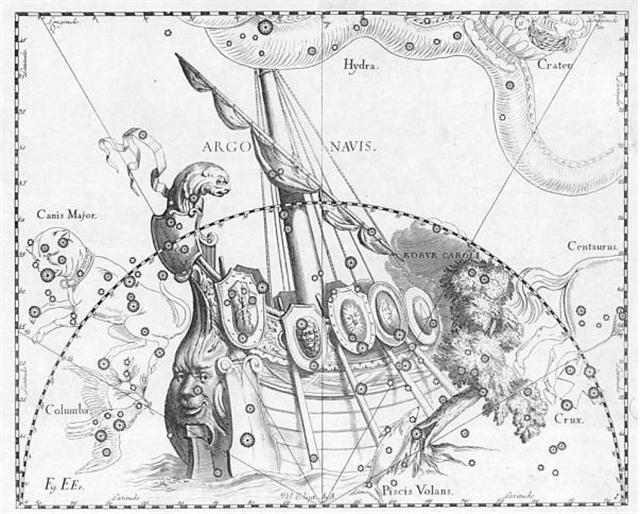 |
|
NAKSHATRA DATES: |
|
NOV 13 |
14 |
15 |
16 (*240) |
17 |
18 (322) |
|
ι Sagittarii (301.2),
TEREBELLUM = ω Sagittarii, ξ Aquilae (301.3),
ALSHAIN (Falcon) = β Aquilae
(301.6), φ Aquilae (301.8) |
ε Pavonis, θ Sagittarii (302.3), γ Sagittae
(302.5), μ Pavonis (302.7 |
τ Aquilae (303.8) |
20h (304.4)
η Sagittae (304.2), δ Pavonis (304.4)
*263.0 = *304.4 - *41.4 |
SHANG WEI (Higher Guard) =
κ
Cephei
(305.2),
θ
Sagittae (305.4),
TSEEN FOO (Heavenly Raft) =
θ
Aquilae (Ant.)
(305.6), ξ Capricorni (305.8)
*264.0 = *305.4 - *41.4 |
TSO KE (Left Flag) =
ρ
Aquilae
(306.3) |
|
Jan 16 |
17 |
18 (383) |
19 |
20 |
21 |
|
°Jan 12 |
13 (378) |
14 |
15 (*300) |
16 |
17 |
|
'Dec 20 (354) |
SOLSTICE |
22 |
23 |
CHRISTMAS EVE |
25 (*279) |
|
"Dec 6 (340) |
7 |
8 |
9 |
10 |
11 (*265) |
|
DAY 301 |
302 |
303 = 120 + 183 |
304 |
305 |
306 |
| E vae
ra - ka oho - ki te henua - kua huki |
ku
kikiu - te henua |
32 |
|
Huki. 1. Pole
attached to the poop from which the
fishing-net is suspended: huki kupega. 2. Digging stick. 3. To
set vertically, to stand (vt.).
4. Huki á te mahina, said of the
new moon when both its horns have become
visible. Vanaga. 1. To post up, to
publish. 2. To cut the throat (uki).
Mq.: Small sticks which close up the
ridge of a house. Ha.: hui, the
small uniting sticks in a thatched
house. Churchill. Standing upright.
Barthel. M. Spit for roasting. Te
Huki, a constellation. Makemson.
Hukihuki. 1. Colic. 2. To
transpierce, a pricking. 3. To sink to
the bottom. Churchill.
HUI¹,
v. Haw., to unite together, to
mix, to add one to another, to assemble,
meet; s. cluster, collection of
things; huihui, a bunch, cluster;
huiuna (for huiana), a
seam in a garment; la-hui,
collection of people, a nation. Sa.
sui, to dilute, to add ingredients
to a thing; sui, to sew, to
thread beads; susui, to mend,
repair; susuia, to fasten the
ridge-pole of a house. Tong., hui,
mingle, mix, join; fufui, a flock
of birds. N. Zeal., hui, huhui,
to gather, mix, unite; ra-hui, a
company; ka-hui, a herd, a flock.
Tah., hui, a collection of
persons, a company; hui-hui manu,
flock of birds; hui-tara-wa,
Orion's belt. Marqu., huhui, a
bundle of taro. Sanskr., yu, to
bind, join, mix; yuj, to join;
yuga, a yoke, a pair, a couple;
yûti, mixing; yûtha, flock of
birds or beasts. Greek, ζευγνυμι,
to join, put to, yoke up, bind, fasten;
ζευγος,
a yoke of beasts, pair, couple;
ζυγον,
the yoke; ζωνη,
belt, girdle. Lat., jugum,
a yoke; jugo,
bind up, tie together; jungo,
bind, join, unite. Goth., juk,
a yoke. A.-Sax., geok,
id. Scand., ok,
id. Armen., zugel,
attach together, yoke up;
zoygkh,
a couple, a pair. Pers., yûgh,
a yoke. Irish, ughaim,
harness. Welsh, jow,
yoke. Lett., jûgs,
yoke. Anc. Slav., jgo,
yoke. Bohem., gho,
id. Lith., jungas,
id. A singular coincidence of
application, if it has no nearer
connection, by the Polynesian and the
Latin of this word to similar purposes,
occurs in the huhui
and hui-tarawa
of the
former and jugulæ
of the latter. In Hawaiian
huhui
designates a constellation generally,
but especially that of the Pleiades; in
Tahitian hui-tarawa,
lit. the transverse or horizontal
cluster, designates the stars generally
called Orion's belt, and in Latin
jugulæ
represents the very same stars in the
constellation Orion. HUI²,
v. Haw., to ache, be in pain;
s. bodily pain; niho-hui, the
toothache; hui, huihui,
cold, chilly, as morning air or cold
water; hukeki, hukiki,
cold, shivering on account of wet. N.
Zeal., huka, cold. Tah., hui,
hui-hui, to throb as an artery,
twitchings in the flesh. Sanskr.,
çuch¹,
to be afflicted, grieve; çuch²,
to be wet, fetid; çuch,
s., sorrow, grief; quære
suçîma,
cold? To this Sanskr. çuch
Benfey
refers the Goth. hiufau,
to mourn, lament, and the O. H. Germ.
huvo,
an owl. (Fornander) |
 |
 |
|
Cb3-1 (50) |
Cb3-2 (392 + 51 = 443) |
|
CLOSE TO THE SUN: |
|
Dec 5 (339 = 156 + 183) |
6 |
|
'Nov 8 (312 = 339 - 27) |
9 |
|
"Sept 25
(298 = 339 - 41) |
26 |
|
CLOSE
TO THE FULL MOON: |
|
5h (76.1)
ε Leporis (76.0),
CURSA
= β Eridani
(76.4), λ Eridani (76.7)
*35.0 = *76.4 - *41.4 |
μ Aurigae, μ Leporis (77.6) |
|
June 5 (156 = 115 + 41) |
6 |
|
'May 9 (129 = 115 + 14) |
10 |
|
Vaitu Nui 25 (115 =
230 / 2) |
26 |
|
...
In view of the almost universal
prevalence of the Pleiades year
throughout the Polynesian area it is
surprising to find that in the South
Island and certain parts of the North
Island of New Zealand and in the
neighboring Chatham Islands, the year
began with the new Moon after the yearly
morning rising, not of the Pleiades, but
of the star Rigel in Orion ...
 |
|
manu pao i te hau tea - kua tu |
manu rere ki te hau tea - kua tu |
manu rere ki te hau tea |
kiore - henua |
|
Pao.
To cut off, to throw a
lance. Churchill.
Paopao,
spade, shovel, rubbish, to lacerate,
to have a quarrel with. Churchill.
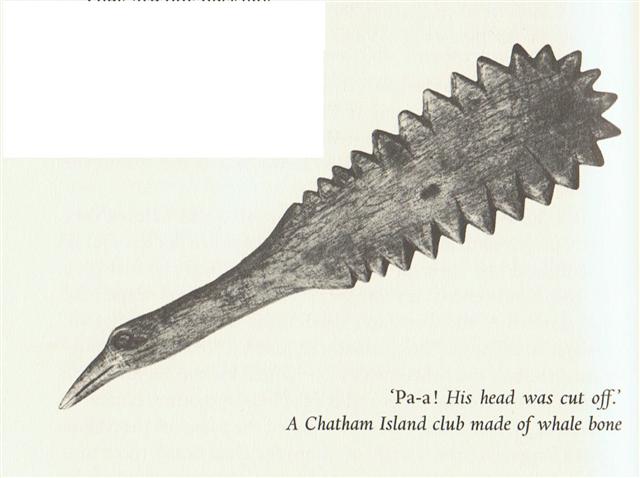
There are 27 teeth
around the tail of the bird above. |
 |
 |
 |
 |
|
Cb4-13 → 14 * 29½ |
Cb4-14 (477 = 392 + 85) |
Cb4-15 |
Cb4-16 (87 = 3 * 29) |
|
CLOSE TO THE FULL MOON: |
| no
star listed (110) |
ALUDRA (Virgin) = η Canis Majoris
(111.1),
PROPUS = ι Gemini (111.4),
GOMEISA (Water-eyed) = β Canis
Minoris
(111.6)
*70.0 = *111.4 - *41.4 |
ρ Gemini (?) (112.1),
Eskimo Nebula = NGC2392 Gemini
(112.2)
ANTARES
(α Scorpii)
|
Al Dhirā'-5 (Forearm) /
Punarvasu-7 /
Mash-mashu-Mahrū-10 (Western One of
the Twins)
CASTOR (Beaver)
= α Gemini
*113.4 = *41.4 + *72.0 |
|
July 9 (10 * 19) |
10 |
11 |
12 (193 = 152 + 41) |
|
'June 12 (190 - 27) |
13 (164) |
14 |
15 |
|
"May 29 (190 - 41) |
30 (150) |
31 |
Te Maro 1 (8 * 19 → 9 * 91) |
|
... The jaguar
learned from the grasshopper that
the toad and the rabbit had stolen
its fire while it was out hunting,
and that they had taken it across
the river. While the jaguar was
weeping at this, an anteater came
along, and the jaguar suggested that
they should have an excretory
competition. The anteater, however,
appropriated the excrement
containing raw meat and made the
jaguar believe that its own
excretions consisted entirely of
ants. In order to even things out,
the jaguar invited the anteater to a
juggling contest, using their eyes
removed from the sockets: the
anteater's eyes fell back into
place, but the jaguar's remained
hanging at the top of a tree, and so
it became blind. At the request of
the anteater, the macuco bird made
the jaguar new eyes out of water,
and these allowed it to see in the
dark. Since that time the jaguar
only goes out at night. Having lost
fire, it eats meat raw. It never
attacks the macuco ...'
 |
|
erua marama |
tagata
noho i to mea |
kua vaha |
|
Vaha.
Hollow; opening; space between the fingers (vaha
rima); door cracks (vaha papare).
Vahavaha, to fight, to wrangle, to
argue with abusive words. Vanaga.1. Space,
before T; vaha takitua, perineum. PS
Mgv.: vaha, a space, an open place.
Mq.: vaha, separated, not joined.
Ta.: vaha, an opening. Sa.: vasa,
space, interval. To.: vaha, vahaa,
id. Fu.: vasa, vāsaà, id.
Niuē: vahā. 2. Muscle, tendon;
vahavaha, id. Vahahora (vaha
1 - hora 2), spring.
Vahatoga
(vaha 1 - toga 1), autumn. 3.
Ta.: vahavaha, to disdain, to
dislike. Ha.: wahawaha, to hate, to
dislike. Churchill. |
 |
 |
 |
 |
|
Cb4-17 (392 + 88) |
Cb4-18 |
Cb4-19 |
Cb4-20 |
|
CLOSE TO THE SUN: |
|
Jan 12 (377) |
13 |
14 |
15 (197 + 183 = 380) |
|
ε Sagittae (297.1), σ Aquilae (Ant.)
(297.4),
SHAM
(Arrow) = α Sagittae
(297.8)
*256.0 = *297.4 - *41.4 |
β Sagittae (298.0), χ Aquilae (298.3), ψ
Aquilae (298.8) |
υ Aquilae (299.1),
TARAZED (Star-striking Falcon) = γ Aquilae
(299.3), δ Sagittae (299.6), π Aquilae
(299.9) |
Sravana-23 (Ear or Three Footprints)
TYL =
ε
Draconis
(300.0),
ζ
Sagittae (300.1),
ALTAIR
(Flying Eagle) =
α
Aquilae
(300.3),
ο
Aquilae (300.5),
BEZEK =
η
Aquilae
(Ant.)
(300.8) |
|
DAY 297 |
298 |
299 |
300 |
|
CLOSE TO
THE FULL MOON: |
|
ANA-TAHUA-VAHINE-O-TOA-TE-MANAVA-7 (Pillar
for elocution)
υ Gemini (114.0),
MARKAB PUPPIS = κ Puppis
(114.7), ο Gemini (114.8),
PROCYON = α Canis Minoris
(114.9) |
α Monocerotis (115.4), σ Gemini (115.7)
*74.0 = *115.4 - *41.4 |
Mash-mashu-arkū-11 (Eastern One of the
Twins)
κ Gemini (116.1),
POLLUX
= β Gemini
(116.2), π Gemini (116.9) |
AZMIDISKE = ξ Puppis
(117.4)
*76.0 = *117.4 - *41.4 |
|
July 13 |
14 |
15 |
16 (197) |
|
'June 16 |
17 |
18 |
19 (170) |
|
Te
Maro 2 |
3 |
4 (5 * 31) → 18 * 29½ |
5 (156 = 12 * 13) |
|
DAY 114 |
115 |
116 |
117 |
 |
Day 156 (Te Maro 5) - day 136 (MAY 16) = 20.
However, the time-frame of the Bull (as I have defined
it by
the empty (zero) glyph space at the beginning of side
a on the G tablet) was *64 right ascension days
before the time-frame of rongorongo, which in turn
was *41 right ascension days later than the
time-frame of Bharani. And *64 - *41 = *23, i.e.
not 20 days.
The conclusion could be that we ought to go back in
the glyph text to the end of side b on the G tablet
in order to look for *61 (= *41 + *20). North of the
equator day 61 (as counted from December 31) could
have implied the first day of March, 1 + 31 + 28 + 1
= 32 + 29 = 61.
|
MARCH 14 → π |
15 |
(365 + 75 = 440) |
17 |
18 |
19 |
20 (*364) |
 |
 |
 |
 |
 |
 |
 |
|
Gb8-24 (229 + 236) |
Gb8-25
(466) |
Gb8-26 |
Gb8-27 |
Gb8-28 |
Gb8-29 |
Gb8-30 (242) |
|
CLOSE TO THE SUN: |
|
MENKHIB (Next to the Pleiades = ζ
Persei
(57.6)
PORRIMA
(γ Virginis)
|
ZAURAK (The Boat) = γ Eridani
(58.9) |
λ Tauri (59.3), ν Tauri (59.9) |
4h (60.9)
JĪSHUĬ = λ Persei
(60.7)
COR
CAROLI (α Canum Ven.)
|
υ
(48) Persei
(61.2) |
BEID (Egg) = ο¹ Eridani
(62.2), μ Persei (62.8)
VINDEMIATRIX ( ε Virginis) |
Al Dabarān-2 (The Follower)
HYADUM I = γ Tauri
(63.4)
*22.0 = *63.4 - *41.4 |
|
May 17 (137) |
18 (*58) |
19 (*424) |
20 |
21 |
22 |
23 (*428) |
|
°May 13 |
14 (*54) |
15 (*420) |
16 (136) |
17 |
18 (*58) |
19 (*424) |
|
'April 20 |
21 (111) |
22 |
23 |
24 |
25
(*400) |
26 (*36) |
|
"April 6 |
7 |
8 |
9 (464) |
10 (100) |
11 |
12 (*22) |
|
DAY 57 |
58 |
59 |
60 |
61 |
62 |
63 |
 |
|
NAKSHATRA DATES: |
|
λ
Librae (240.0),
β
Tr. Austr. (240.3),
κ
Tr. Austr. (240.4),
ρ
Scorpii (240.8) |
Iklīl al Jabhah-15 (Crown of the
Forehead) /
Anuradha-17 (Following Rādhā) /
Room-4 (Hare)
ξ
Lupi,
λ
Cor. Bor.(241.1),
ZHENG =
γ
Serpentis,
θ
Librae (241.2),
VRISCHIKA = π Scorpii
(241.3),
ε
Cor.
Borealis (241.5),
DSCHUBBA (Front of Forehead) = δ
Scorpii (241.7),
η Lupi (241.9) |
υ
Herculis (242.3),
ρ
Cor. Borealis (242.4),
ι
Cor. Borealis (242.5),
θ
Draconis (242.6),
ξ
Scorpii (242.7)
*201.0 = *242.4 - *41.4
SCHEDIR
(α Cassiopeiae)
|
16h (243.5)
ACRAB (Scorpion) = β Scorpii, JABHAT
AL ACRAB (Forehead of the Scorpion)
= ω Scorpii
(243.3), θ Lupi,
RUTILICUS = β Herculis
(243.5),
MARFIK (Elbow) = κ Herculis
(243.7), φ Herculis (243.8) |
ψ
Scorpii (244.6),
LESATH
(Sting) = ν Scorpii
(244.8) |
χ
Scorpii (245.1),
YED PRIOR (Hand in Front) = δ
Ophiuchi,
δ
Tr.
Austr. (245.5) |
YED POSTERIOR (Hand Behind) = ε
Ophiuchi,
RUKBALGETHI SHEMALI (Northern Knee
of the Giant) =
τ
Herculis
(246.6).
δ
Apodis (246.7),
ο
Scorpii (246.8) |
|
Lesath
was a name both for ν (*244) and for
υ (*264) Scorpii, and there were 20
right ascension days from ν to υ.
... Upsilon
(uppercase Υ, lowercase υ; Greek:
ύψιλον, ýpsilon ... is the 20th
letter of the Greek alphabet. In the
system of Greek numerals, Υ has a
value of 400. It is derived from the
Phoenician waw ... Waw (wāw
'hook') is the sixth letter of the
Semitic abjads ...
|
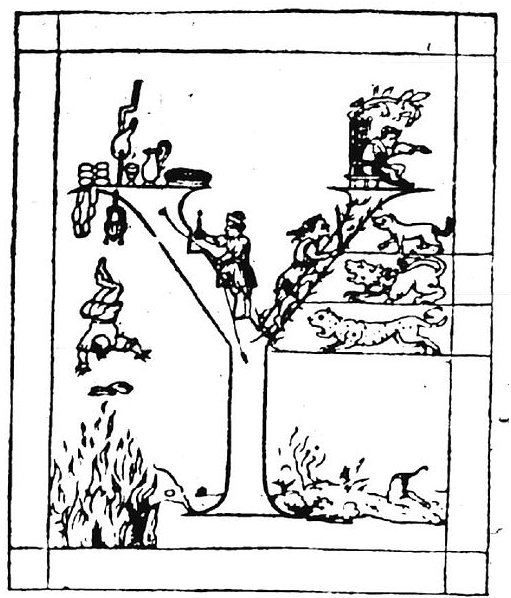
...
Upsilon is known as
Pythagoras' letter, or
the Samian letter,
because Pythagoras used
it as an emblem of the
path of virtue or vice
... |
|
Hora Iti
29 (241) |
46 |
Tangaroa
Uri 15 (288) |
14 |
30 (264 +
39) |
|
SPICA
(202) |
ANTARES
(288 - 39) |
LESATH
(264) |
|
48 |
15 |
|
9 weeks |
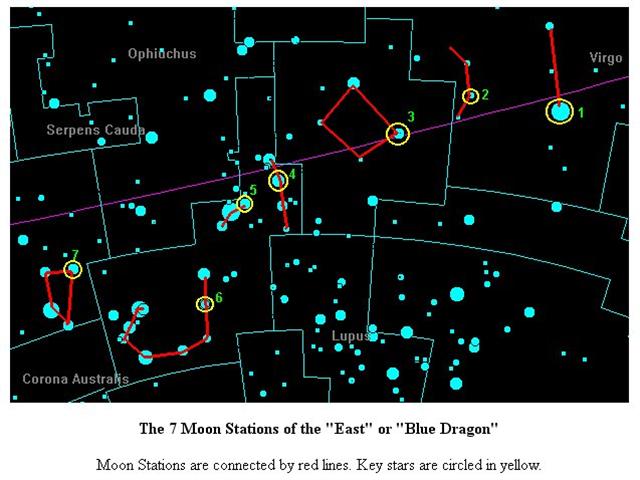
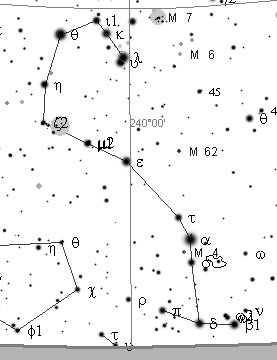
|
|
Nov 16 |
17 |
18
(*242) |
19 |
20 (324) |
21 |
22 |
|
°Nov 12 (*236) |
13 |
14 |
15 |
16 (320) |
17 |
18
(*242) |
|
'Oct 20 |
21 (*214) |
22 (295) |
23 |
24 |
25 |
26 (299) |
|
"Oct 6 |
7 (*200) |
8 |
9 |
10 |
11 |
12 (285) |
|
SEPT 13 |
14 (*177) |
15 |
16 |
(260 = 244 + 16) |
18 |
19 |
|
DAY 240 |
241 |
242 |
243 |
244 (= 4 * 61) |
245 |
246 |
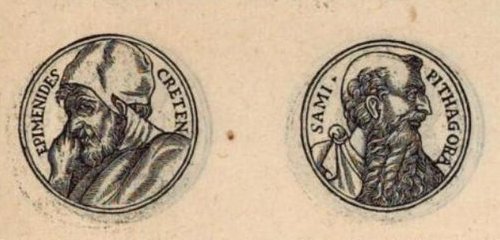
|




















